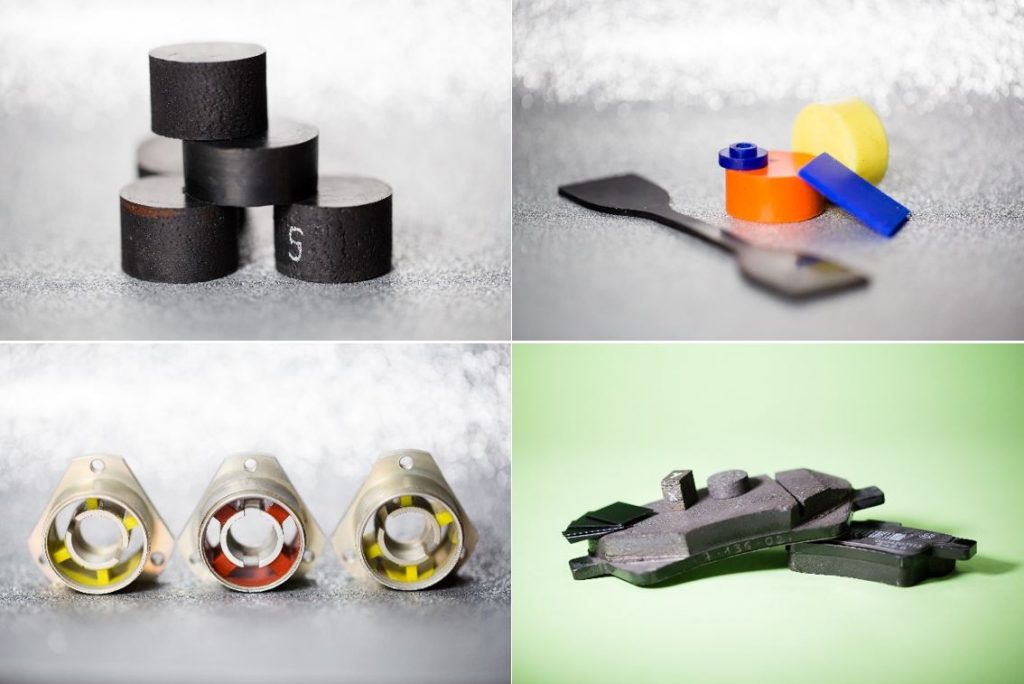Viscoelasticity in a few minutes …
Polymer materials possess a considerable capacity to dissipate vibration energy. They are used to protect structures, equipment and passengers from vibration stresses, impacts and noise.

The challenges of characterising viscoelastic materials experimentally
To characterise these materials, their dynamic rigidity and loss angle are classically represented as a function of stress frequency. These experimental observations highlight the considerable evolution of these magnitudes as a function of frequency ranges (figure 2).
 Figure 2 : Representations of frequency
Figure 2 : Representations of frequency
The experimental characterisation of these properties, called Dynamic Mechanical Analysis is difficult because the frequency range to be covered by the test resources is often very large and hard to access with only one experimental device. Furthermore, the mechanical characteristics of viscoelastic materials strongly depends on temperature. The first solution is to make use of the principle of time-temperature equivalence. This method is based on vibration tests in a relatively narrow frequency bandwidth carried out at different temperatures. Time-temperature equivalence permits building the dynamic behaviour of the material over a large frequency bandwidth for a given temperature.
This method presents several measurement biases the chief of which stems from the time-temperature equivalence hypothesis which is not always verified depending on the material studied. In many cases of materials stemming from industry such as multilayer materials, loaded polymers, functionalised materials and structural adhesives, the time-temperature equivalence is not valid. The characterisation of the material’s dynamic properties must therefore be done at the temperature and frequency bandwidth corresponding to its real utilisation conditions.
Over the last few decades, the VAST team has developed innovative and efficient viscoanalysers capable of directly characterising the dynamic mechanical properties of these materials in different stress configurations (traction-compression, shearing, combined static and dynamic loading, etc.). These new experimental technologies (figure 3) now permit the direct characterisation of viscoelastic materials (without time-temperature equivalence and without passing via modes specific to the experimental set up) up to 10kHz.
 Figure 3 : 3 viscoanalyzers developed at Supméca
Figure 3 : 3 viscoanalyzers developed at Supméca
Performing these tests under different pre-loads and different stress amplitudes permits the detailed characterisation of the nonlinear viscoelasticity of the material studied.
The quality of the experimental data obtained from these tests is an essential parameter when predicting the dynamic behaviours of components and structures in which viscoelastic materials are used.
The challenges of modelling viscoelastic materials
The experimental data on the dynamic behaviours of viscoelastic materials are mainly obtained to feed predictive models of components, structures and systems.
The viscoelastic mechanical behaviours can be mainly described by two families of model : those based on non-integer derivatives and those based on elementary rheological components such as the generalised Maxwell model.
The first limitation in modelling stems from the identification of the parameters used in these models. This point has been dealt with in several publications by the VAST team [1 – 3] and exploited by several industrial partners (Hutchinson, BOSCH Braking Systems, AER, ADERIS).
The second limitation dealt with by the VAST team concerns the integration of these models in off-the-shelf structure calculation codes [4,5].
Viscoelasticity has been a highly active area of research for decades and has now found new areas of investigation with functionalised materials, metamaterials, additive manufacturing, bio-sourced and environmentally friendly materials and those that comply with sustainable development.
[1] J.-L. Dion and S. Vialard, “Identification or rubber shock absorber mounts,” Mécanique industrielle et matériaux, vol. 50, no. 5, pp. 232–237, 1997.
[2] F. Renaud, J.-L. Dion, G. Chevallier, I. Tawfiq, and R. Lemaire, “A new identification method of viscoelastic behavior : Application to the generalized maxwell model,” Mechanical Systems and Signal Processing, vol. 25, no. 3, pp. 991 – 1010, 2011.
[3] H. Jrad, J. L. Dion, F. Renaud, I. Tawfiq, and M. Haddar, “Experimental characterization, modeling and parametric identification of the non linear dynamic behavior of viscoelastic components,” European Journal of Mechanics – A/Solids, vol. 42, no. 0, pp. 176 – 187, 2013.
[4] S. Thouviot, G. Chevallier, F. Renaud, J.-L. Dion, and R. Lemaire, “Prise en compte des comportements viscoélastiques dans la simulation dynamique des systèmes de freinage,” Mechanics & Industry, vol. 10, no. 05, pp. 385–396, 2009.
[5] H. Festjens, G. Chevallier, F. Renaud, J.-L. Dion, and R. Lemaire, “Effectiveness of multilayer viscoelastic insulators to prevent occurrences of brake squeal : A numerical study,” Applied Acoustics, vol. 73, no. 11, pp. 1121 – 1128, 2012.



